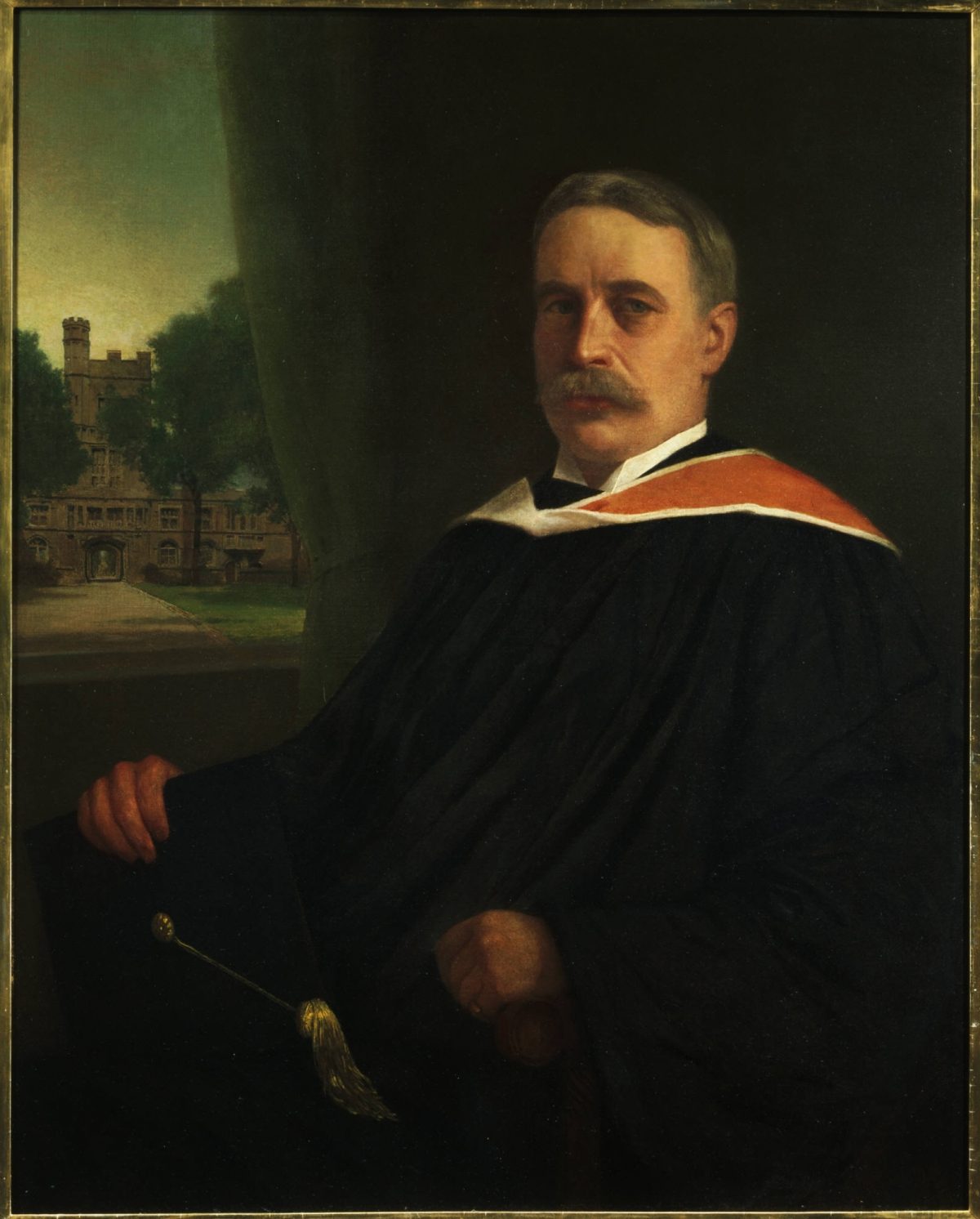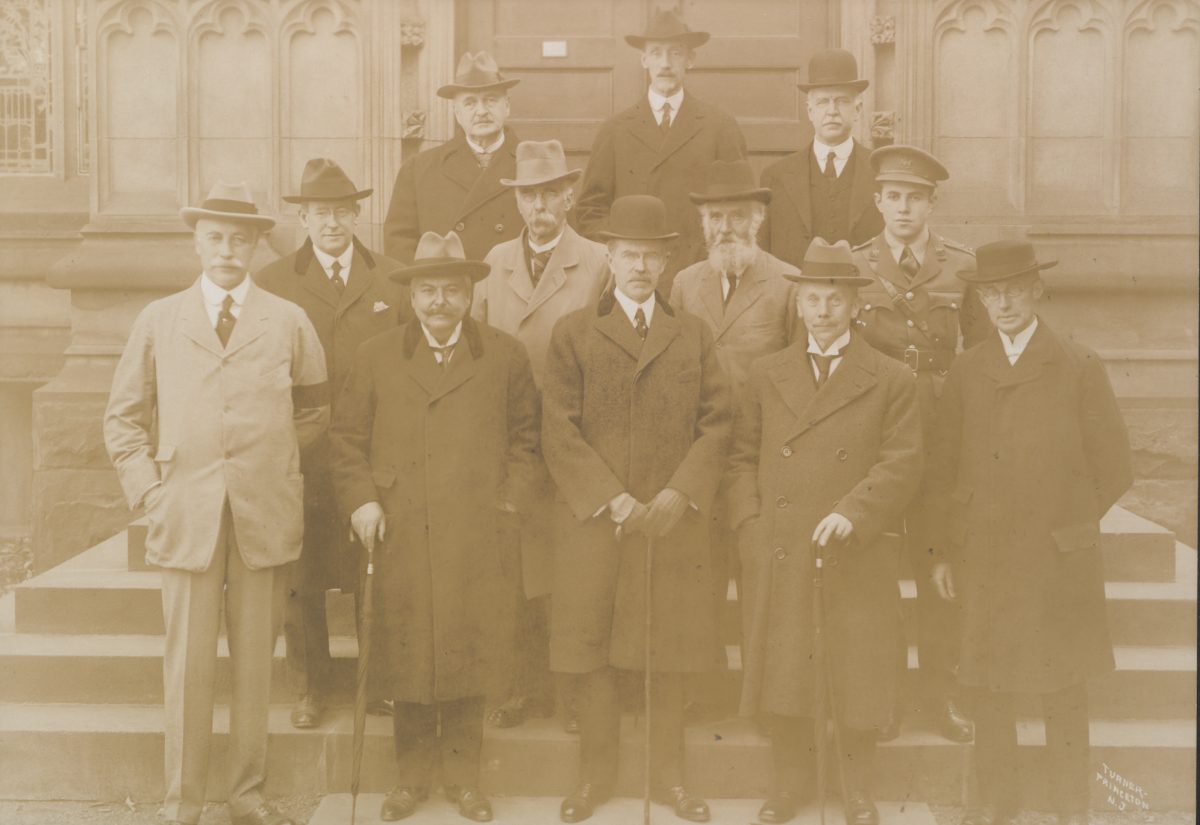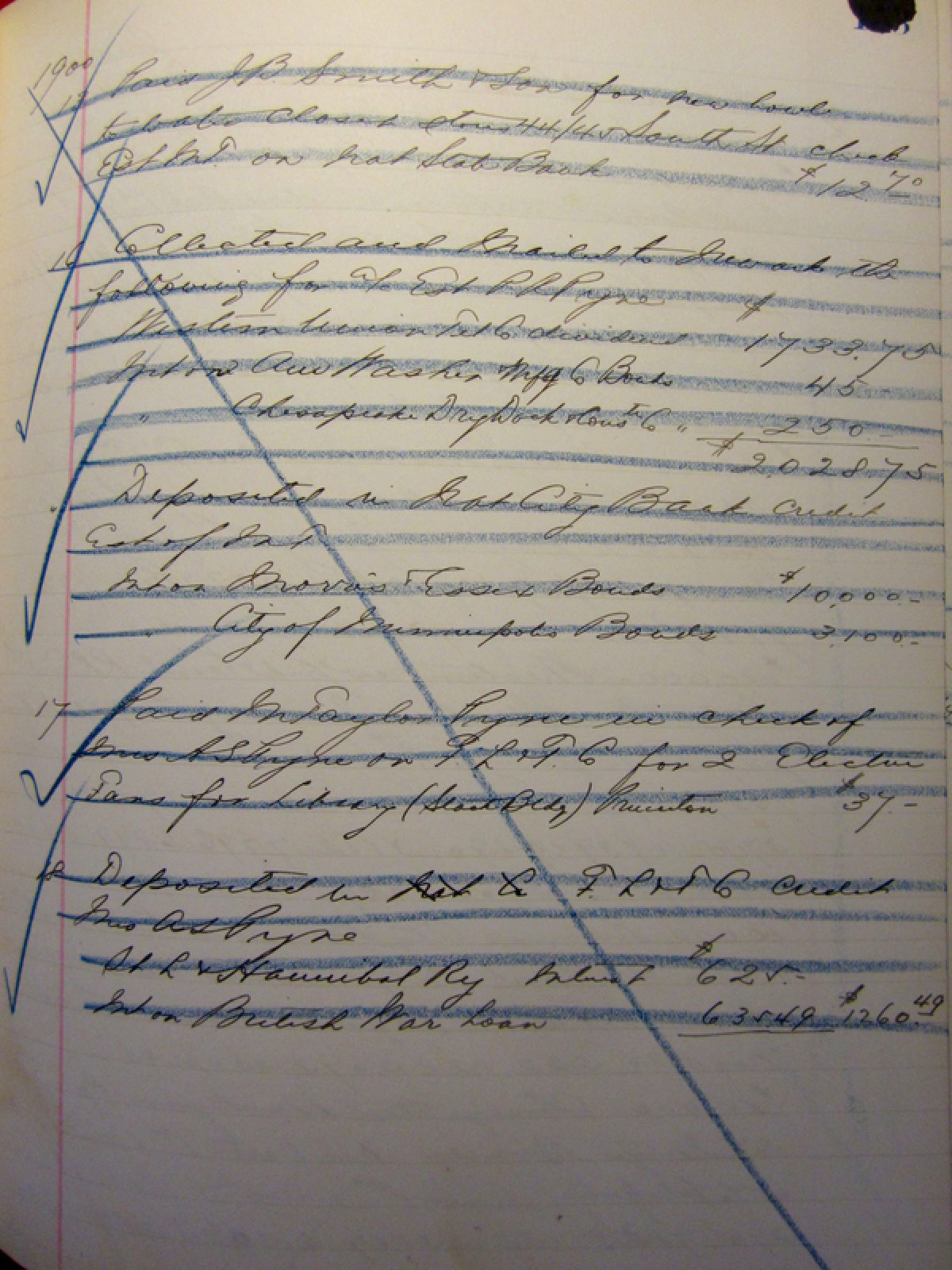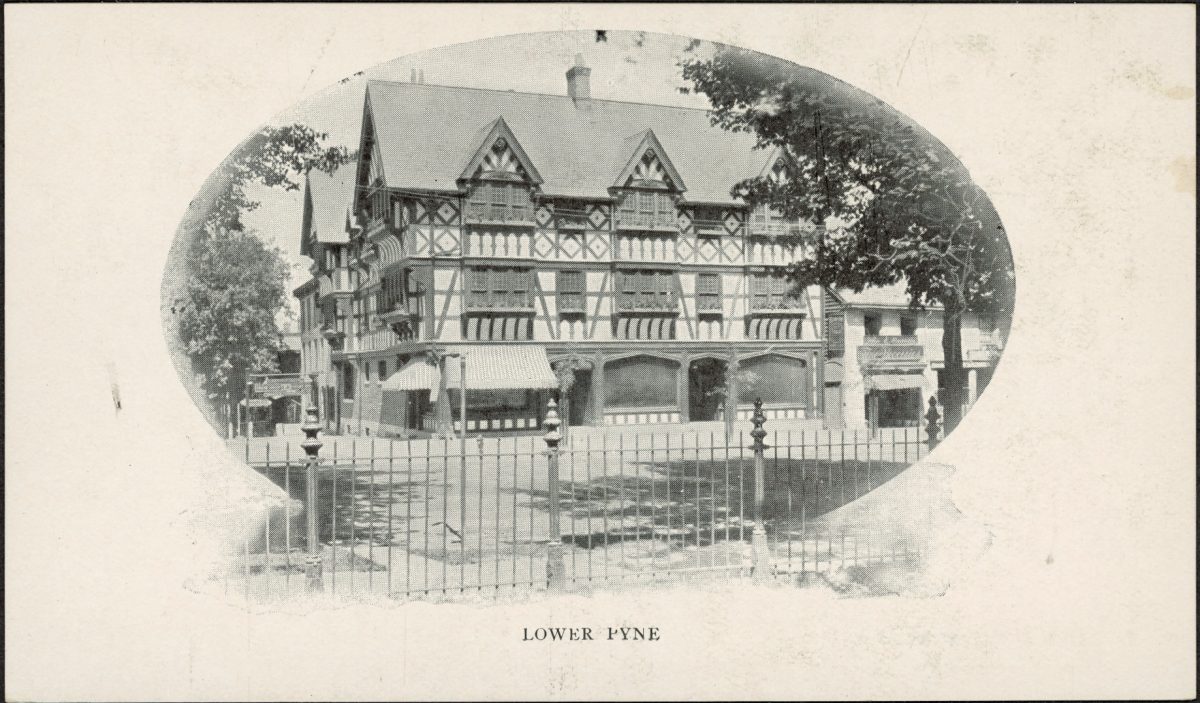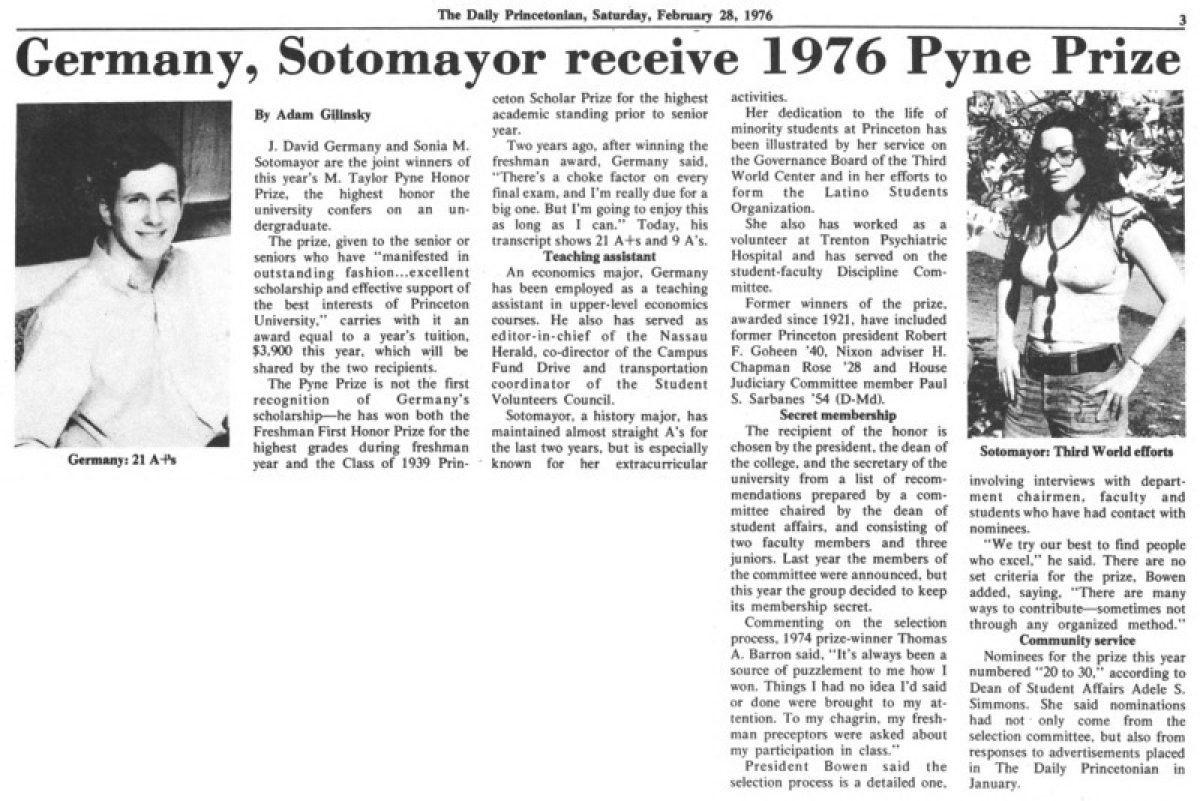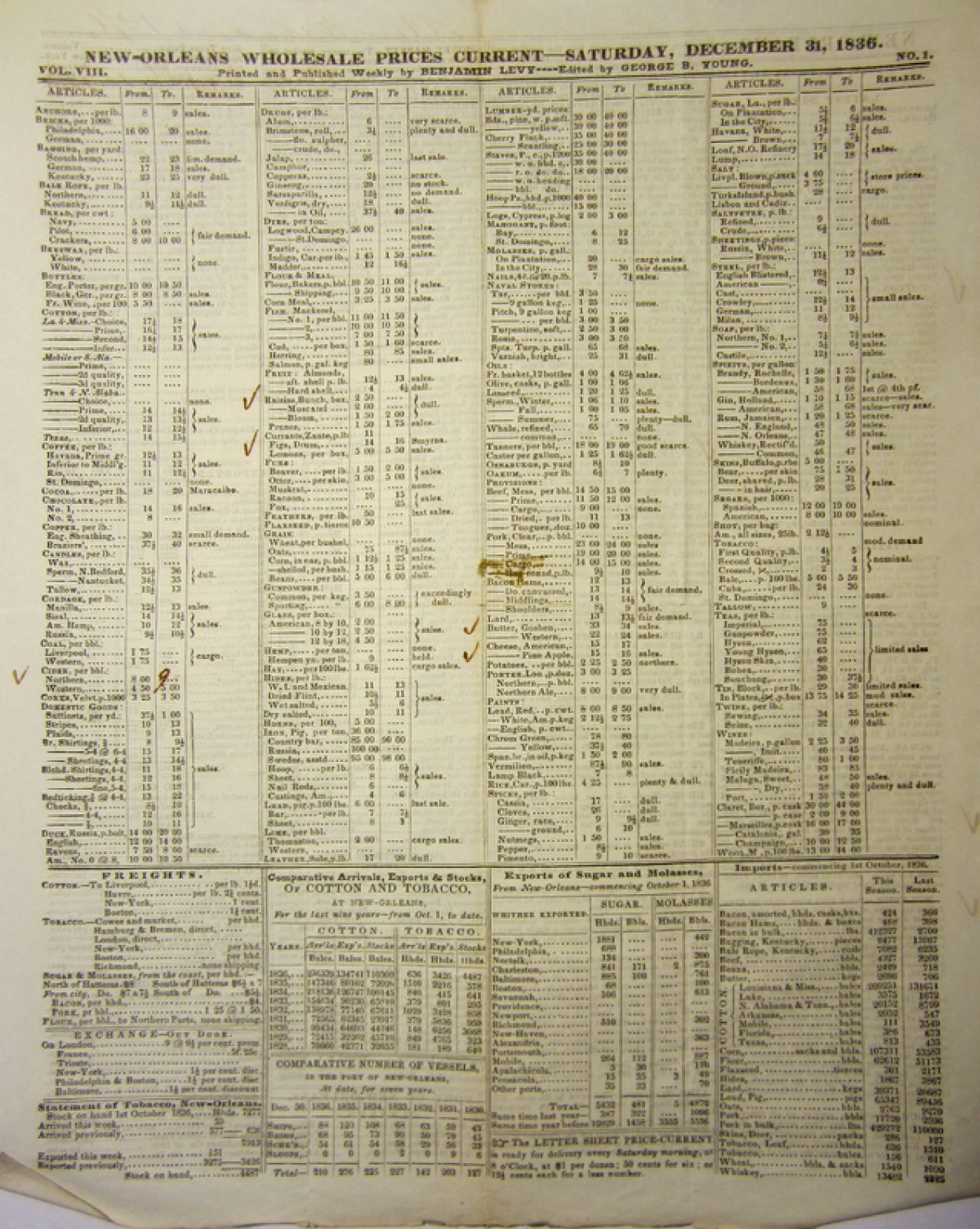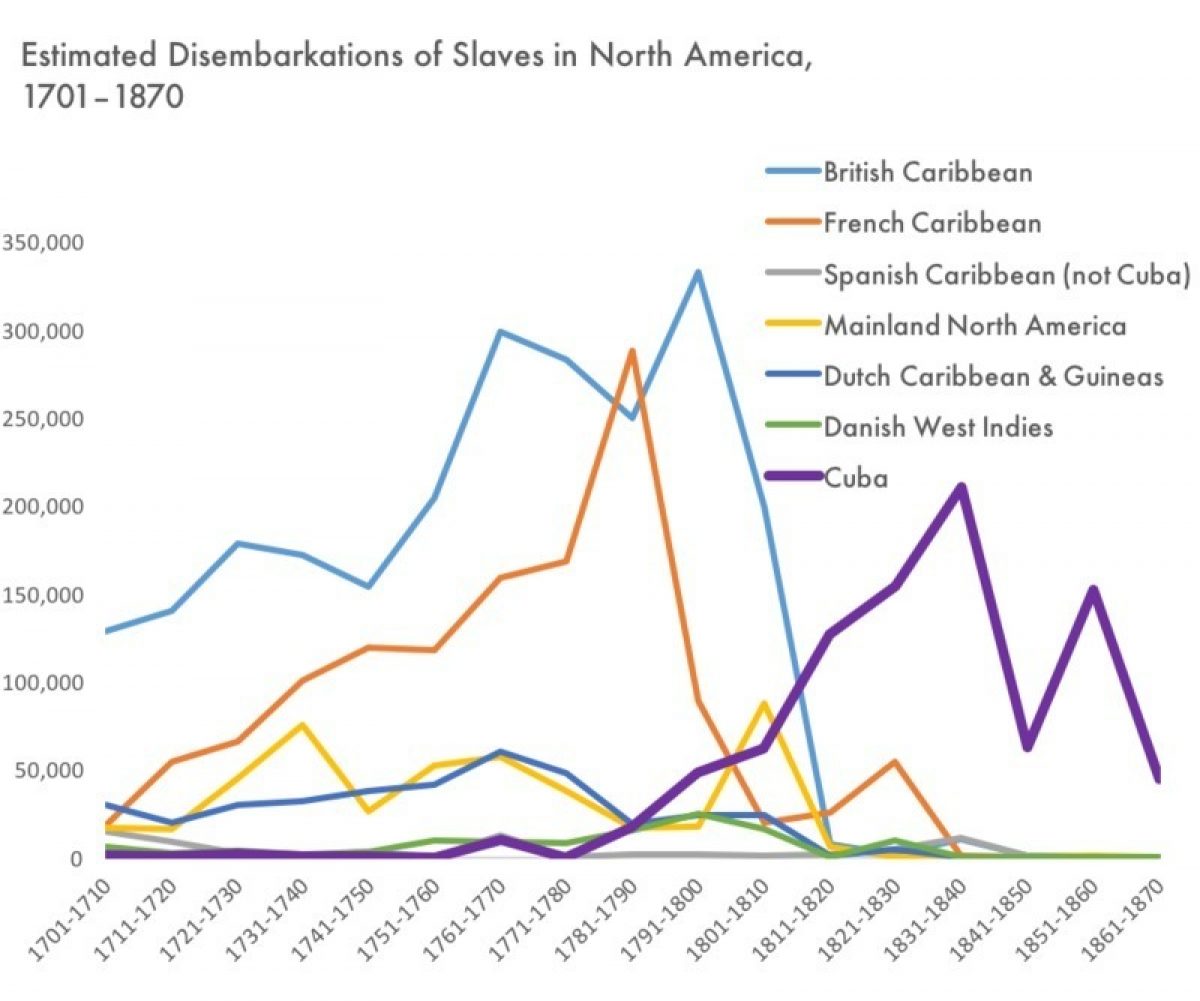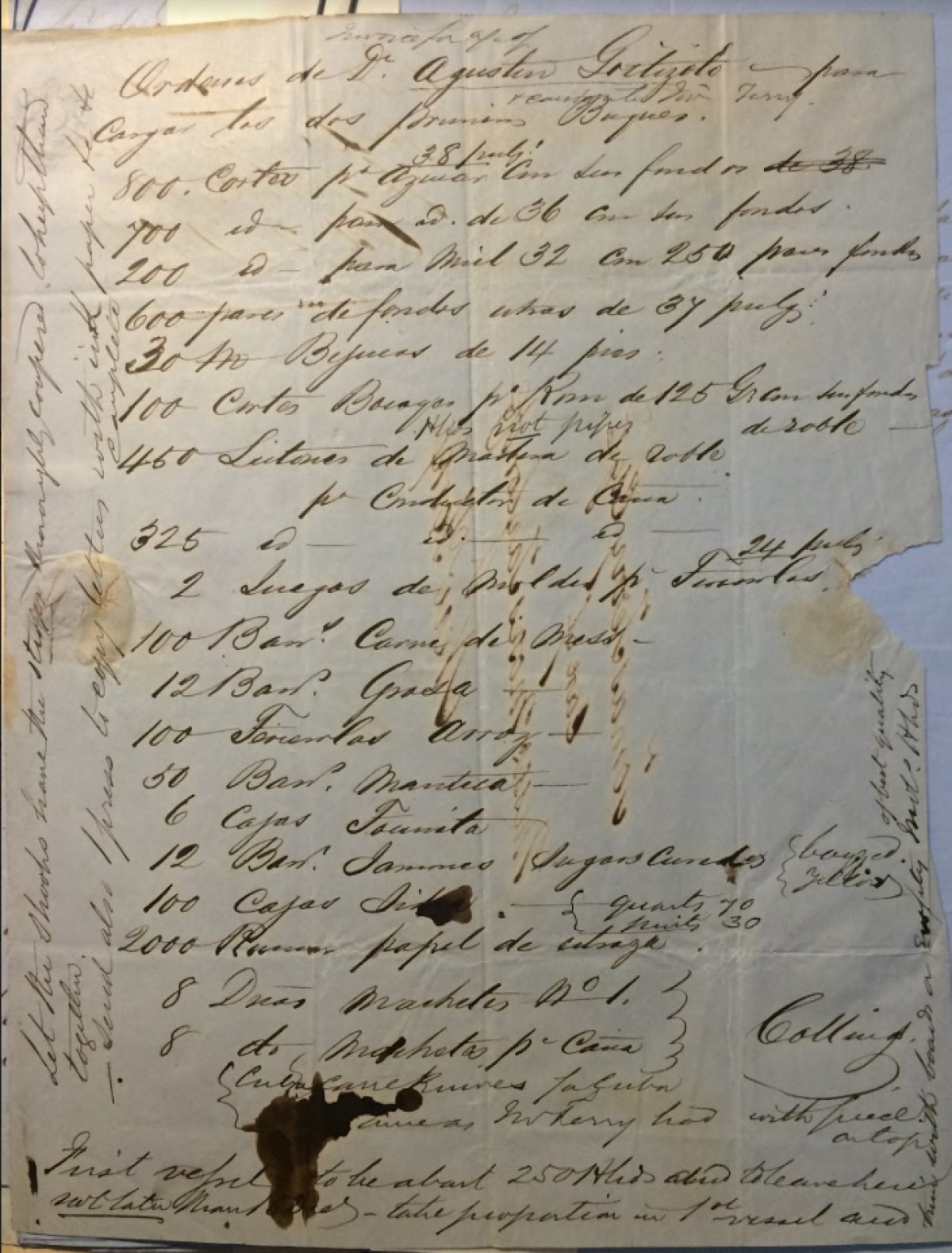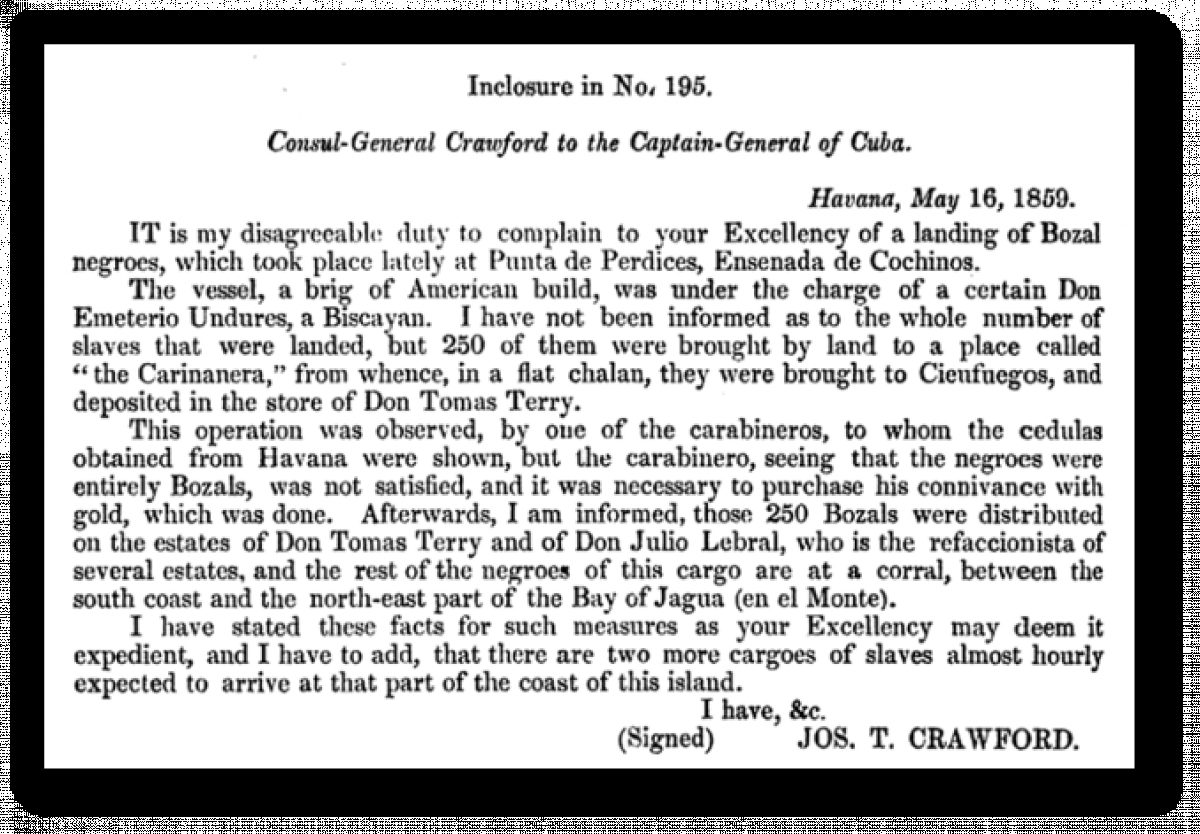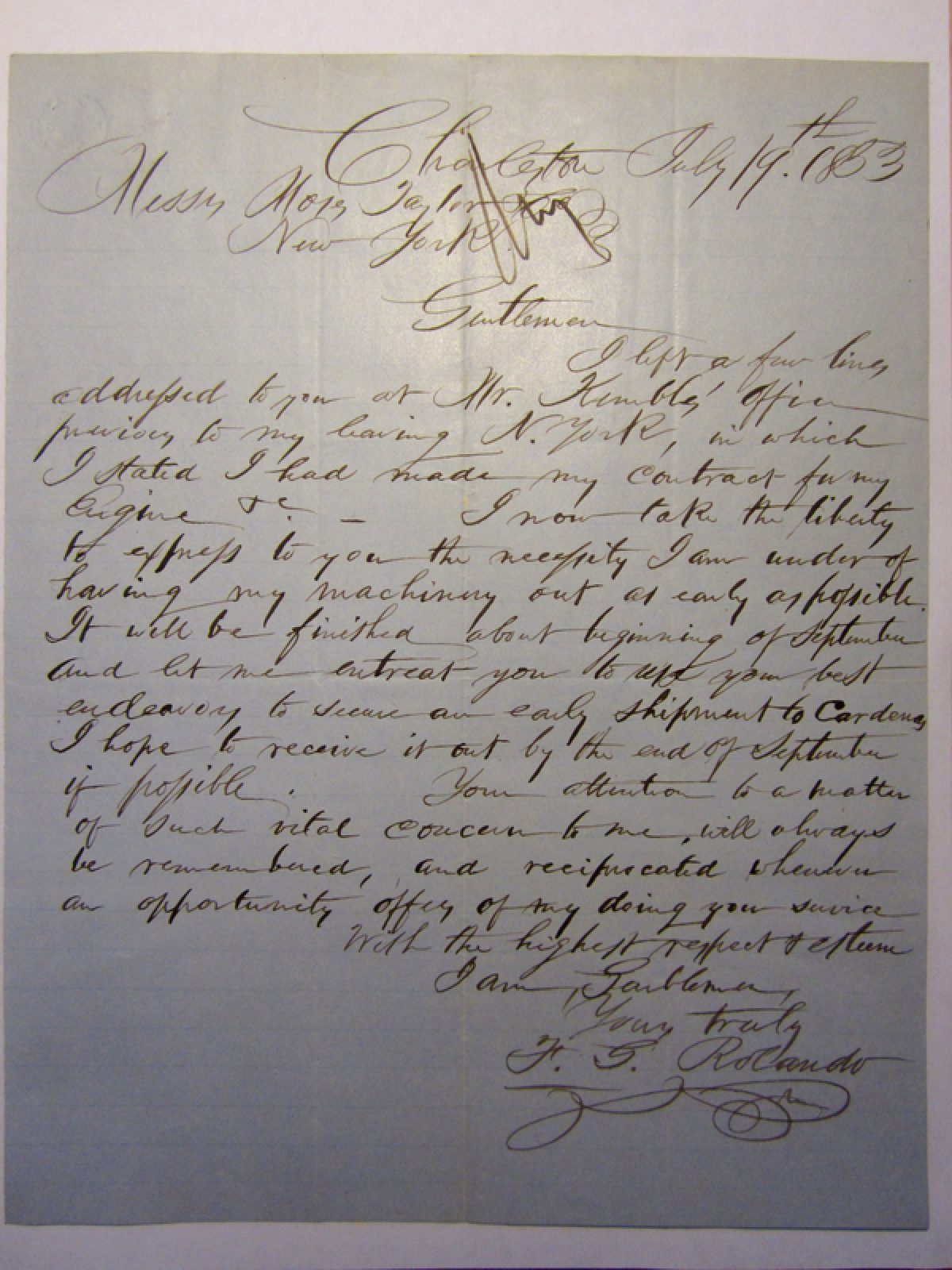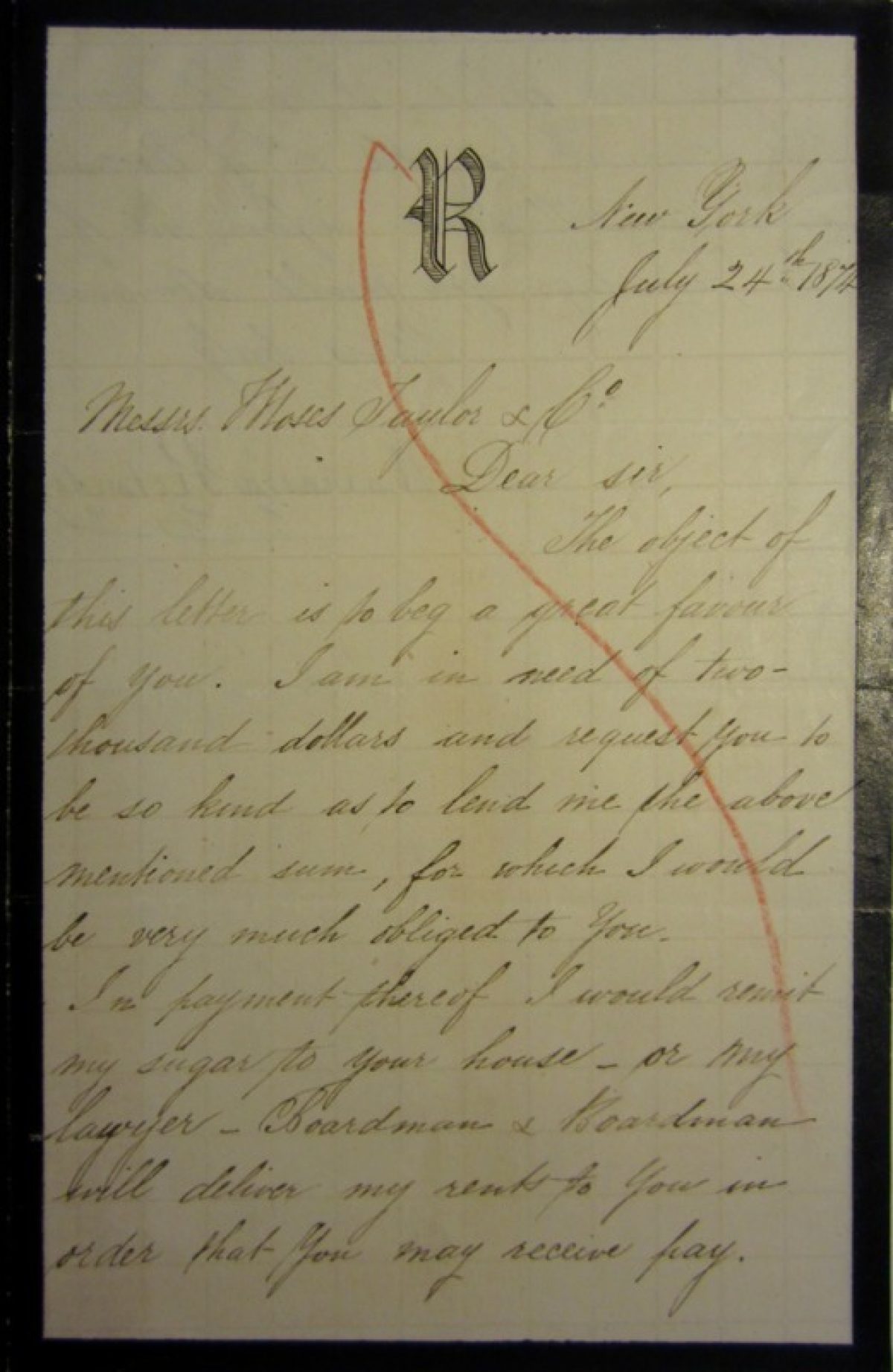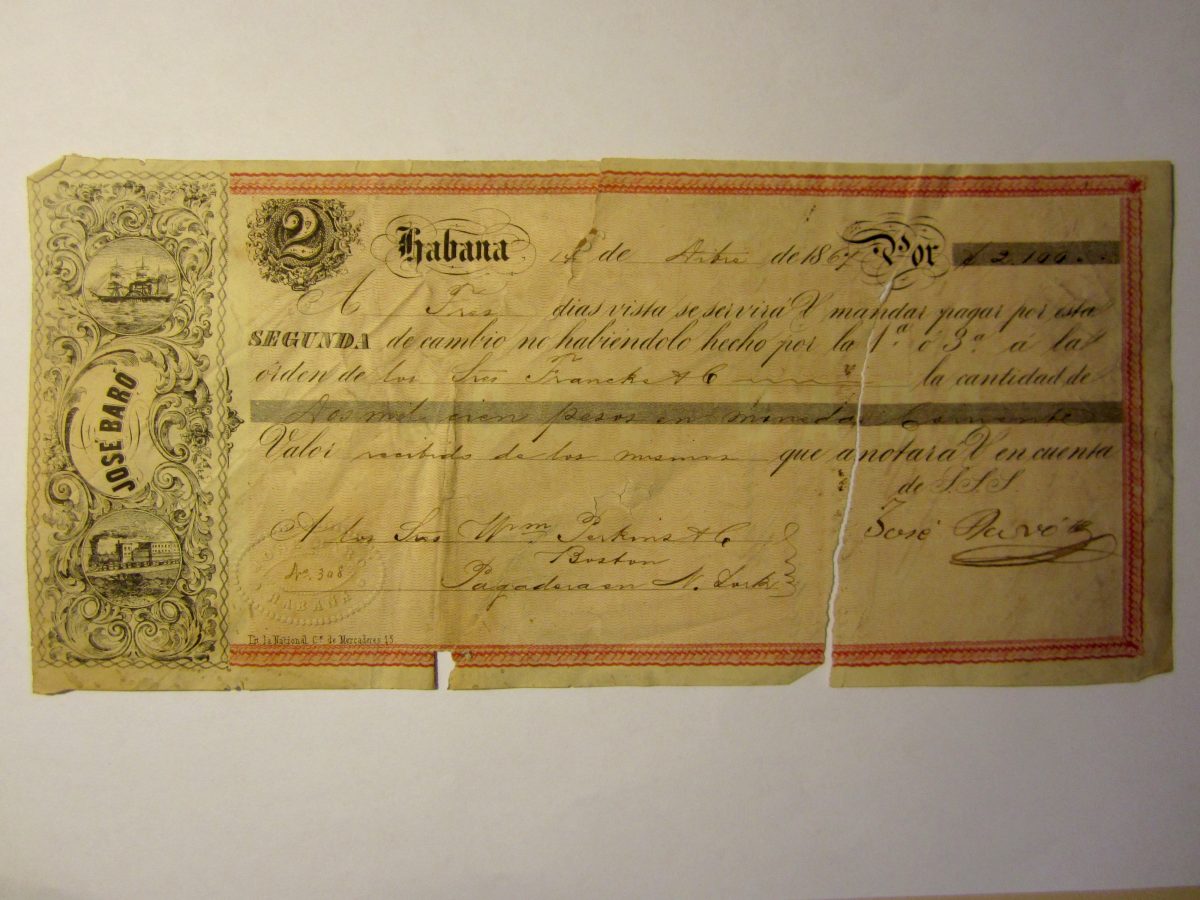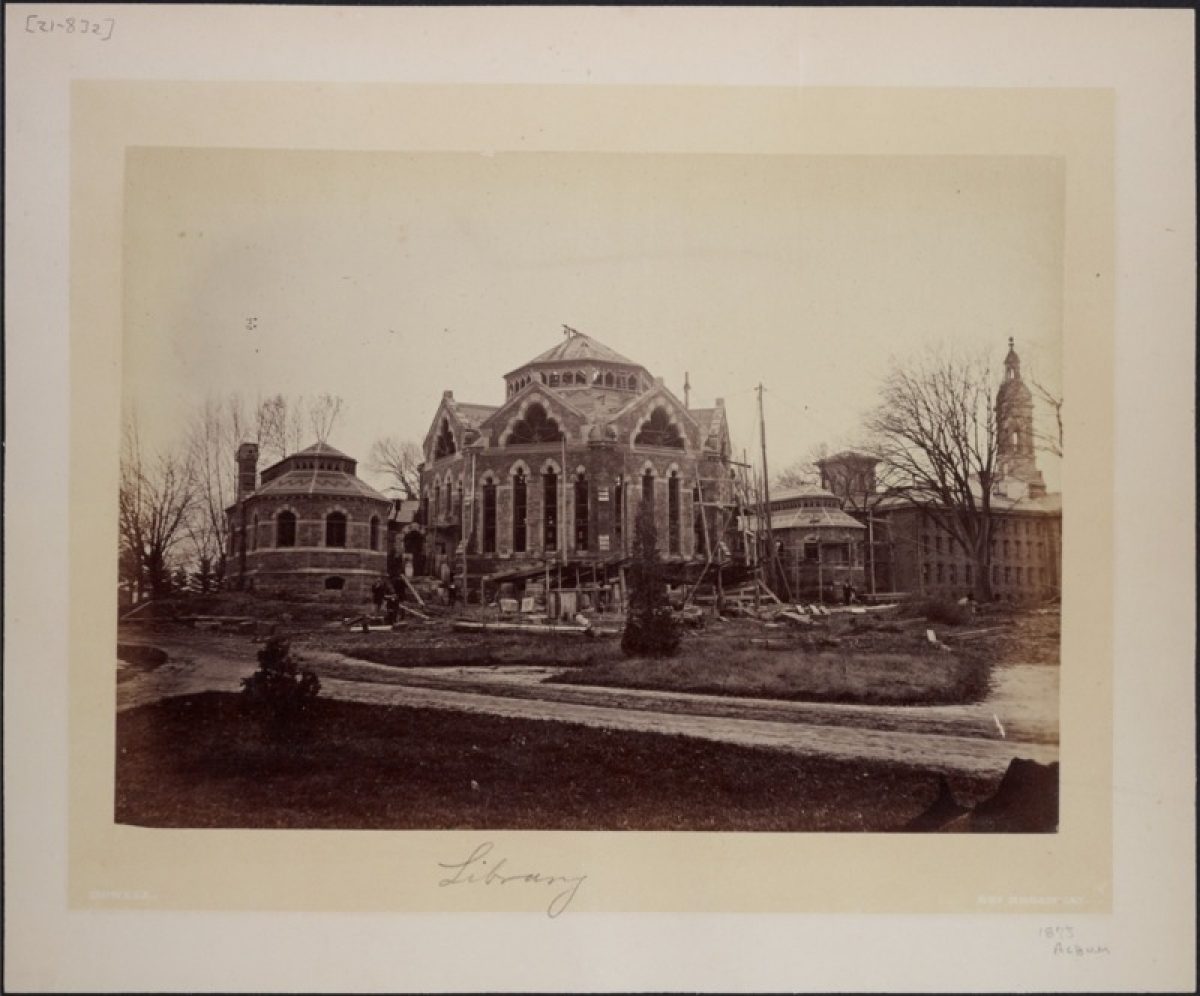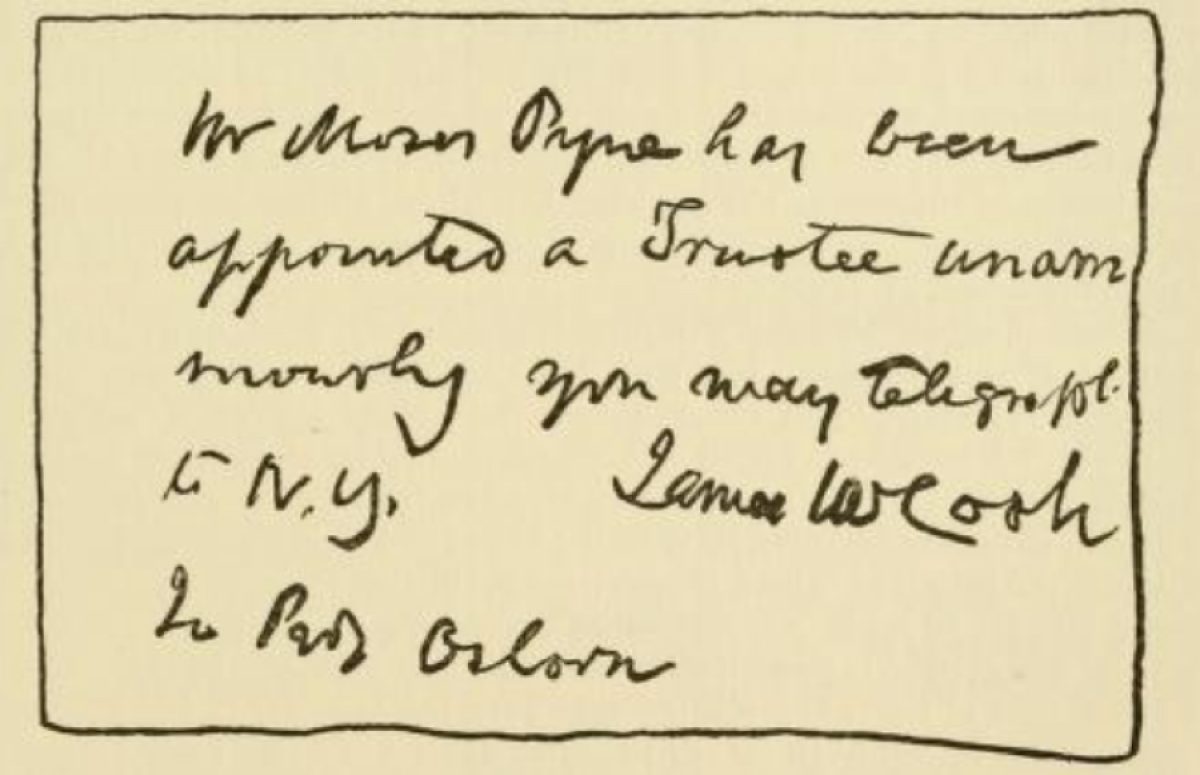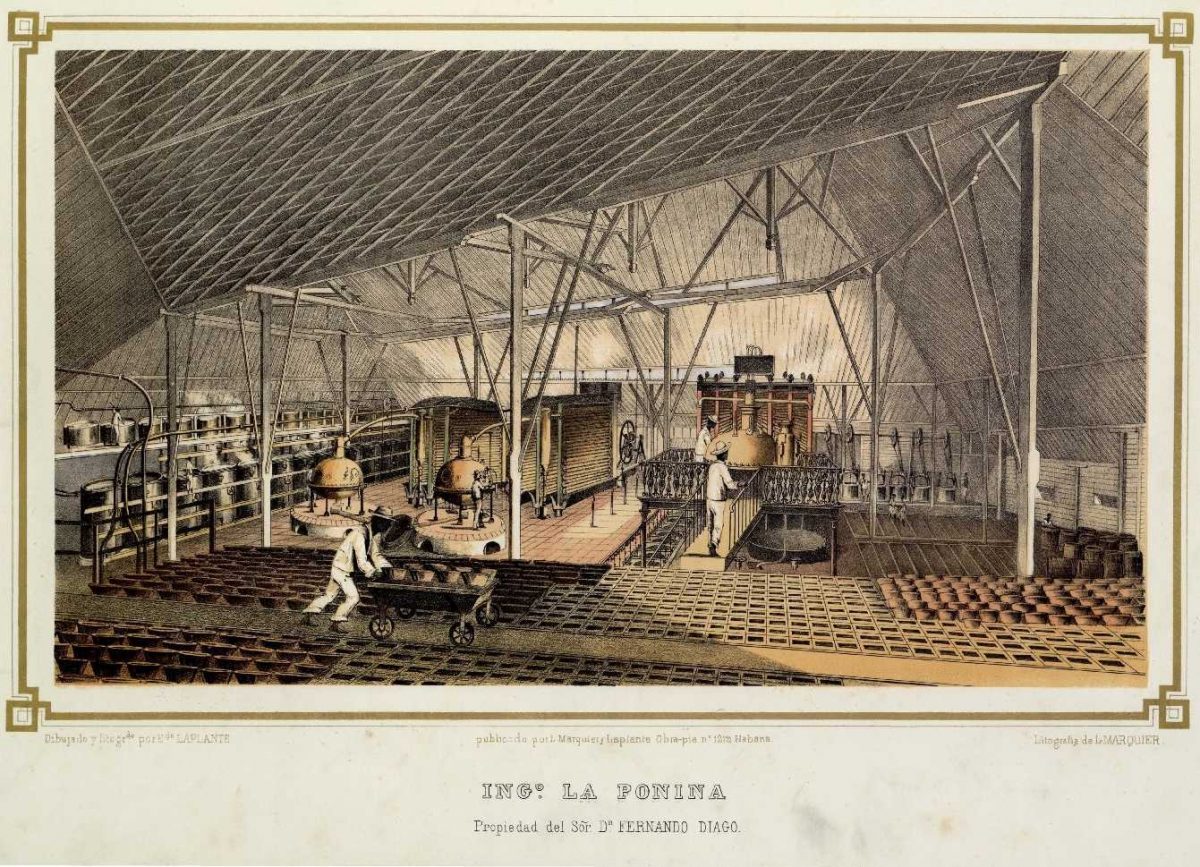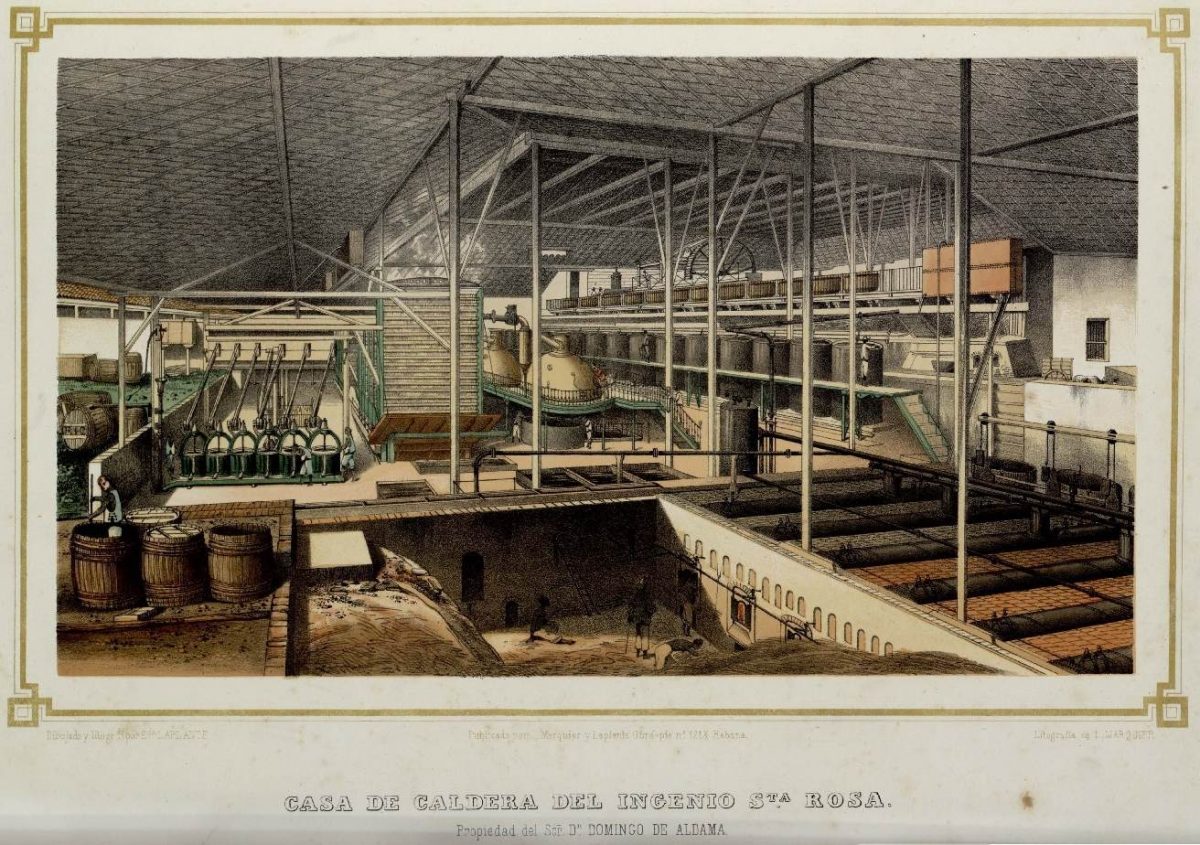[1]
Account Book 300, 2:153, Entry for July 17, 1900, Box 213, Moses Taylor Papers, New York Public Library. For background on the construction of a new wing to the then-existing Chancellor Greene Library, see: “Chancellor Green Working Library,” Alumni Princetonian, Jan. 27, 1898, Larry DuPraz Digital Archives; James Axtell, The Making of Princeton University: From Woodrow Wilson to the Present (Princeton, NJ: Princeton University Press, 2006), 441–43.
⤴
[2]
For a full list of the payments made to Moses Taylor Pyne, see Account Book 300, Vols. 1 & 2, Box 213, Moses Taylor Papers.
⤴
[3]
Obituary, Princeton Alumni Weekly, Apr. 27, 1921, 663. In 1926, one alum estimated that Pyne’s donations “would exceed a total of a million and a half” dollars. See John Alexander Campbell, “The Class of ’77 Before and After Graduation,” in Fifty Years of Princeton, ed. Henry Fairfield Osborn (Princeton: Princeton University Press, 1927), 11.
⤴
[4]
This tentative estimate is based on a compilation of all the payments for the construction of the Stack Library that appear in Account Book 300 ($487,810). Using Morgan Friedman’s online “Inflation Calculator,” accessed at http://www.westegg.com/inflation/, this estimated total equates to roughly $14 million dollars in the present day.
⤴
[5]
For Pyne’s financial contributions that supported the construction of undergraduate dormitories on Nassau Street, see William Barksdale Maynard, Princeton: America’s Campus (University Park, PA: Pennsylvania State University Press, 2012), 62–63. For his support of new faculty and graduate housing, see Alexander Leitch, A Princeton Companion (Princeton, NJ: Princeton University Press, 1978), 77. For his numerous endowments to the university, including endowments in support of a historical seminar, library fund, professorship, and his annual gifts to the university’s Income Account, see Campbell, “The Class of ’77 Before and After Graduation,” 11. For the amount of the Pyne Professorship Fund, established in 1913 with a gift of $25,000, see Princeton University, Official Register of Princeton University (Princeton, NJ: Princeton University, 1921), 13:52.
⤴
[6]
“Princeton’s Most Loyal Son,” Daily Princetonian, Apr. 23, 1921. See also Photograph, “Princeton Flag Flying at Half Mast Over Pyne Tower of the Graduate College…,” Daily Princetonian, Apr. 26, 1921.
⤴
[7]
Adam Gillinsky, “Germany, Sotomayor Receive 1976 Pyne Prize,” Daily Princetonian, Feb. 28, 1976.
⤴
[8]
For examples of how Pyne’s wealth is described in relationship to Princeton, see: J. David Hoeveler, Jr., James McCosh and the Scottish Intellectual Tradition: From Glasgow to Princeton (Princeton: Princeton University Press, 1981), 296 (“Pyne was the son of a very successful New York financier who had emigrated from London and made his way to the presidency of the National City Bank and the directorships of many American railroads.”); Leitch, A Princeton Companion, 399 (“A man of great inherited wealth, accumulated originally by his maternal grandfather, Moses Taylor (first president of the National City Bank of New York and the principal stockholder in the Delaware, Lackawanna and Western Railroad Company…”); Maynard, Princeton: America’s Campus, 62 (“New York railroad lawyer and key university trustee Moses Taylor Pyne, immensely rich after the death of his bank-president father…”); P.C. Kemeny, Princeton in the Nation’s Service: Religious Ideals and Educational Practice, 1868–1928 (New York: Oxford University Press, 1998), 82 (“Moses Taylor Pyne…a wealthy businessman”); Jane Martin, “The Vital Power of a Great Affection,” Princeton Alumni Weekly, Mar. 8, 2006 (“Son and grandson to presidents of the National City Bank in New York City, Pyne was born into a large fortune.”).
⤴
[9]
For older scholarship tracing the links between Pyne’s maternal grandfather, Moses Taylor, and the sugar trade of the Americas, see: Roland T. Ely, Cuando Reinaba su Majestad El Azúcar: Estudio Histórico-Sociológico de una Tragedia Latinoamericana: El Monocultivo en Cuba, Origen y Evolución del Proceso, 2nd ed. (Havana: Ediciones Imagen Contemporanea, 2001); Roland T. Ely, “The Old Cuba Trade: Highlights and Case Studies of Cuban-American Interdependence during the Nineteenth Century,” Business History Review 39, no. 4 (1964): 456–78; Daniel Herbert Hodas, “The Business Career of Moses Taylor: Merchant, Finance Capitalist and Industrialist” (PhD diss., New York University, 1974). For more recent examples of scholars who have sought to excavate the economic links between slavery in the Caribbean and the rise of commercial sector in America more generally, see: Stephen Chambers, “No country but their counting-houses”: The U.S.-Cuba-Baltic Circuit, 1809–1812,” in Slavery’s Capitalism: A New History of American Economic Development, ed. Sven Beckert and Seth Rockman (Philadelphia: University of Pennsylvania Press, 2016), 181–94; Eric Kimball, “What have we to do with slavery?”: New Englanders and the Slave Economies of the West Indies,” in Slavery’s Capitalism, 195–208; Calvin Schermerhorn, “The Coastwise Slave Trade and a Mercantile Community of Interest,” in Slavery’s Capitalism, 209–25. See also Calvin Schermerhorn, The Business of Slavery and the Rise of American Capitalism, 1815–1860 (New Haven, CT: Yale University Press, 2015).
⤴
[10]
Hodas, “The Business Career of Moses Taylor,” 9.
⤴
[12]
For Percy Pyne’s increasingly prominent role in the day-to-day management of the firm, see Ely, Cuando Reinaba su Majestad El Azúcar, 177–81; Ely, “The Old Cuba Trade,” 461; Hodas, “The Business Career of Moses Taylor,” 22.
⤴
[13]
Ely, “The Old Cuba Trade,” 460 (“On a national scale, it could be said that Moses Taylor & Co. had captured something like one-fifth of the entire sugar trade between Cuba and the United States.”).
⤴
[14]
Ibid, 449–450 (using existing, albeit incomplete, account books to estimate an average profit of $200,000 between 1861 and 1865).
⤴
[15]
For examples of the firm’s early overtures to firms in New Orleans, see Moses Taylor & Co. to Cuculla, Lapeyere & Co., Nov. 18, 1835, Vol. 1, Moses Taylor Papers (“It will…afford me great pleasure if in any other manner our correspondence can be rendered mutually interesting. Should you have occasion for my services here you will find me disposed to make liberal advances & if you can occasionally point out favorable opportunities I shall have no object to enter into operations of joint a/c.”); Moses Taylor & Co. to L. Hodge, Esq., Nov. 20, 1835, Vol. 1, Moses Taylor Papers (“It will be very agreeable to me if our correspondence can be rendered more interesting…”); Moses Taylor & Co. to Eastman & Bros., Feb. 11, 1836, Vol. 1, Moses Taylor Papers (“…I assure you that my best efforts shall be used to promote your interest on all occasions.”); Moses Taylor & Co. to L. Hodge, Esq., Feb. 11, 1836 (“I…shall be gratified if any opportunity may occur of rendering our intercourse more active & beneficial.”); Moses Taylor & Co. to Chapman & Castillo, Feb. 17, 1836, Vol. 1, Moses Taylor Papers (“With the assurance of my earnest desire to render our intercourse mutually agreeable & advantageous…”). For examples of the frequency of the firm’s correspondence with commission agents in Charleston over the course of a two month period in 1836, see Moses Taylor & Co. to F. & C. Winthrop, Jan. 7, 1836; Moses Taylor & Co. to F. & C. Winthrop, Jan. 14, 1836; Moses Taylor & Co. to F. & C. Winthrop, Jan. 18, 1836, Moses Taylor & Co. to F. & C. Winthrop, Feb. 5, 1836; Moses Taylor & Co.to F. & C. Winthrop, Feb. 15, 1836, Moses Taylor & Co. to F. & C. Winthrop, Feb. 20, 1836; Moses Taylor & Co. to F. & C. Winthrop, Feb. 27, 1836, all in Vol. 1, Moses Taylor Papers. For examples of the firm’s correspondence with firms in Richmond, Virginia, see Moses Taylor & Co. to Davenport Allen & Co., Jan. 23, 1836, Vol. 1, Moses Taylor Papers.
⤴
[16]
See: Courier Letter Sheet Price Current, Charleston, Jan. 1, 1836; New-Orleans Wholesale Price Current, New Orleans, Jan. 14, 1837; Savannah Shipping and Commercial List, Savannah, Feb. 4, 1836, all in Box 3, Moses Taylor Papers.
⤴
[17]
For the firm’s decision to specialize in sugar, see Hodas, “The Business Career of Moses Taylor,” 51–52.
⤴
[18]
For background on the rise of the slave trade in Cuba across the nineteenth century, see Laird W. Bergad, Fe Iglesias García, and María del Carmen Barcia, The Cuban Slave Market: 1780–1880 (New York: Cambridge University Press, 1995), 38 (“Between 1790 and 1867 over 780,000 African slaves were imported to Cuba making the island the greatest slave-importing colony in the history of the Spanish empire and the center of the nineteenth-century slave trade to the Caribbean.”). For scholarship tracing the continuities of slavery that extended beyond the formal emancipation in the islands, see: Thomas C. Holt, The Problem of Freedom: Race, Labor, Politics, in Jamaica and Britain, 1843–1938 (Baltimore: Johns Hopkins University Press, 1992); Natasha Lightfoot, Troubling Freedom: Antigua and the Aftermath of British Emancipation (Durham: Duke University Press, 2015); Padraic Xavier Scanlan, “Blood, Money and Endless Power: Slavery and Capital in British Imperial History,” History Compass14, no. 5 (2016): 218–30.
⤴
[19]
For background on the history of the slave trade and the rise of the plantation economy in the Caribbean, see: Ramiro Guerra y Sánchez, Azúcar y Población en Las Antillas (Havana: Editorial Cultural, 1927); Richard B. Sheridan, Sugar and Slavery: An Economic History of the British West Indies, 1623–1775 (Baltimore: Johns Hopkins University Press, 1974), 234–61; Eric Williams, Capitalism and Slavery (Chapel Hill: University of North Carolina Press, 1944), 30–97; Philip Curtin, The Atlantic Slave Trade: A Census (Madison: University of Wisconsin Press, 1969); Manuel Moren Fraginals, The Sugarmill: The Socioeconomic Complex of Sugar in Cuba, 1760–1860, trans. Cedric Belfrage (New York: Monthly Review Press, 1976), 17–20; Simon P. Newman, A New World of Labor: The Development of Plantation Slavery in the British Atlantic (Philadelphia: University of Pennsylvania Press, 2013), 189–15. For more recent scholarship tracing the trafficking of slaves within the continental North America, see Gregory E. O’Malley, Final Passages: The Intercolonial Slave Trade of British America, 1619–1807 (Chapel Hill: University of North Carolina Press, 2014).
⤴
[20]
Fraginals, The Sugarmill, 15.
⤴
[21]
Steven Mintz, “Introduction,” in African American Voices: A Documentary Reader, 1619–1877, ed. Steven Mintz, 4th ed. (Malden: Wiley-Blackwell, 2009), 27–29.
⤴
[22]
See included table, “Estimated Disembarkations of Slaves from Africa in the Caribbean, 1701–1870,” derived from data available at the Trans-Atlantic Slave Trade Database. For accounts of the impact of the abolition of slavery in the outer lying islands and the rise of the sugar industry in Cuba, see Bergad, The Cuban Slave Market, 23–28.
⤴
[23]
For background on the rise of plantation slavery in Cuba, see: Modesto González Sedeño, Último Escalón Alcanzado Por La Plantación Comercial Azucarera Esclavista: 1827–1886 (Havana: Editorial de Ciencias Sociales, 2003); Fraginals, The Sugarmill, 65–77; Bergad, Cuban Slave Market, 23–28. For a recent account linking the rise of the sugar industry in Cuba to the abundance of land, the availability of inexpensive North American merchants, and the rise in prices for sugar among British planters in the wake of the Haitian Revolution, see David Beck Ryden, West Indian Slavery and British Abolition, 1783–1807 (Cambridge: Cambridge University Press, 2010).
⤴
[24]
For the economic opportunity that Moses Taylor saw in Cuba, see Ely, Cuando Reinaba Su Majestad El Azúcar, 120. On the firm’s direct relationship with planters, see Hodas, “The Business Career of Moses Taylor,” 18; Jonathan Curry-Machado, “Indispensable Aliens: The Influence of Engineering Migrants in Mid-Nineteenth Century Cuba,” (PhD diss., London Metropolitan University, 2003), 65 (noting that the “most powerful planters were able to sell directly to Moses Taylor et al."). For the joint role that Cuba’s elites played in mill ownership and slave trading, see Bergad, The Cuban Slave Market, 28. For a specific example of a planter who exported sugar to Moses Taylor & Co. and imported slaves, see Ely, Cuando Reinaba Su Majestad El Azcúcar, 735, n. 234 (noting that during the 1860s, José Baró invested 1/8th of his capital in the transport of human slaves, purchasing boats capable of carrying between 1,200 and 1,600 slaves).
⤴
[25]
Hodas, “The Business Career of Moses Taylor,” 10. For a more detailed history of the Drake Brothers firm, see Ely, Cuando Reinaba Su Majestad El Azcúcar, 342–384.
⤴
[26]
Quoted in Jehanne Wake, Kleinwort, Benson: The History of Two Families in Banking, (New York: Oxford University Press, 1997), 75. For a firsthand account of a firm within Taylor’s portfolio that included both planters and merchants, see Cárlos Cruzat, Eduardo Echarte, Circular, to Moses Taylor & Co., Nov. 15, 1861, Box 77, Moses Taylor Papers (announcing that “Our Mr. Eduardo Echarte being desirous of giving his especial attention to his rural properties, it has been agreed between him & his partners that the business of the firm shall hereafter be conducted exclusively by Mr. Cárlos Cruzat & Mr. Joaquin de Rojas…).
⤴
[27]
See Tomás Terry to Moses Taylor (Cienfuegos, August 8, 1865), Box 77, Moses Taylor Papers (inquiring how much sugar Terry had on hand at Taylor’s warehouse in New York). For background on the relationship between Terry and Moses Taylor & Co., see Ely, Cuando Reinaba Su Majestad El Azcúcar, 398–416. For an account of Terry’s rise from illegitimate child to one of the largest planters in Cuba, see Martín Rodrigo y Alharilla, “From Periphery to Centre: Transatlantic Capital Flows, 1830–1890,” in The Caribbean and the Atlantic World Economy, eds. Adrian Leonard and David Pretel (Basingstoke: Palgrave Macmillan, 2015), 221.
⤴
[28]
Edwin F. Atkins, Sixty Years in Cuba: Reminscences of Edwin F. Atkins (Cambridge, MA: Riverside Press, 1926), 57.
⤴
[29]
Ely, “The Old Cuba Trade,” 476.
⤴
[31]
Rodrigo y Alharilla, “From Periphery to Centre,” 221.
⤴
[32]
This estimate is based in part on contemporary reports that, by 1854, an estate of “ordinary size” (800 tons) required three hundred slaves. Cristóbal F. Madan, Llamamiento de la Isla de Cuba a Nacion Española (New York: E. Hallet, 1855), 11.
⤴
[33]
Justo Germán Cantero, Los Ingenios: Colección De Vistas De Los Principles Ingenios De Azúcar De La Isla De Cuba, repr. ed.(Havana: Luis Marquier, 1857; Los Angeles: Library of Alexandria, 2012), 74–78. Citations refer to the Library of Alexandria edition.
⤴
[34]
Franciso Céspedes to Moses Taylor & Co., Jan. 20, 1858, Box 77, Moses Taylor Papers.
⤴
[35]
For references to Espelius’ ownership of an estate by this name in 1856 and 1865, see José Manuel Espelius to Moses Taylor & Co. (Havana: Feb. 9, 1856), Box 77, Moses Taylor Papers; see also Estéban Richardo, Caminos De La Isla De Cuba: Itinerarios (Habana: M. Solar, 1865),73.
⤴
[36]
This estimate is based on the number of slaves who received their liberty in 1879, under a deed signed by Antonio González de Mendoza, whose wife inherited her father’s estate. See Alberto Perret Ballester, El Azúcar en Matanzas y Sus Dueños en La Habana (Havana: Editorial de Ciencias Sociales, 2008), 319. For a description of the slave barrack of the Santa Gertrúdis sugar mill that is still inhabited by hundreds of families, see Lorena Tezanos Toral, “The Architecture of Nineteenth-Century Cuban Sugar Mills: Creole Power and African Resistance in Late Colonial Cuba,” (PhD diss., City University of New York, 2015), 128.
⤴
[37]
José Manuel Espelius to Moses Taylor & Co., Feb. 9, 1856, Box 77, Moses Taylor Papers.
⤴
[38]
Cantero, Los Ingenios,74–78.
⤴
[39]
Franciso Céspedes to Moses Taylor & Co., Jan. 20, 1858, Box 77, Moses Taylor Papers.
⤴
[40]
Ramón de la Sagra, Cuba en 1860 (Paris: Simon Raçon & Co., 1863), 94 (citing a workforce of 342 “negros esclavos y 226 chinos.”). For a discussion of the treatment of Chinese coolie laborers, see Evelyn Hu-Dehart, “Chinese Coolie Labor in Cuba in the Nineteenth Century: Free Labor of Neoslavery,” Contributions in Black Studies 12, no. 1 (1994): 38–54.
⤴
[41]
Jorge Bretton-Deschapelles, Memoir, Cuban Summers (Lulu Press: 2012), 150 (“noting that Eden Park “gradually acquired…52 slaves in 1850 and some hundreds more in the 60s”). For background on the Eden Park plantation, see Dorothy Garesché Holland, The Garesché, De Bauduy, and Des Chapelles Families: History and Genealogy (St. Louis: Schneider Printing Co., 1963).
⤴
[42]
Elena Deschapelles to Moses Taylor & Co., Mar. 1, 1878; Elena Deschapelles to Moses Taylor & Co., Jan. 24, 1878; Elena Deschapelles to Moses Taylor & Co., Aug. 12, 1878 (inquiring if Moses Taylor & Company would “sell my bonds in your hands of the Michigan Central & at the Texas & Houston R. Roads…”); Elena Deschapelles to Moses Taylor & Co., Aug. 27, 1878 (“As we require a firm in New York to deposit the first installment of $20,000…I beg to know, if you will not accept said deposit, accept & pay the Bills of Exchange, of said firm, charging your commission, etc…”), George B. Des Chapelles to Moses Taylor & Co., Aug. 30, 1878, Elena Deschapelles to Moses Taylor & Co., Nov. 8, 1878, all in Box 77, Moses Taylor Papers.
⤴
[43]
For a reference to the slave barracks on the estate in 1857, see Cantero, Los Ingeios, 150–51. For a discussion of Diago’s experiments with free labor on his Tinguaro estate, see Gonzalo Aróstequi, “José Silverio Jorrín y Su Tiempo,” Revista de La Facultad de Letras y Ciencias 7, no. 1 (1908), 70.
⤴
[44]
J. Gazaurang to Moses Taylor & Co., Aug. 4, 1849, Box 77, Moses Taylor Papers.
⤴
[45]
Sagra, Cuba en 1860, 93. Note that Sagra includes both Chinese and slaves in the workforce (“La dotacion general es de 368 esclavos y chinos, de los cuales 158 se hallaban ocupados en el corte y la conduction de la cana.”).
⤴
[46]
J. Gazaurang to H.A. Coit, Feb. 26, 1851; J. Gazaurang to H.A. Coit; April 4, 1851, both in Box 77, Moses Taylor Papers. Note that these letters refer only to a shipment of sugar on account of a “Dr. Tomas de Juara,” wihtout referencing the name of the estate from which the shipment originated. Later letters, however, explicitly refer to Conchita, see e.g., Juan Cazaurang to H.A. Coit, July 18, 1851, Box 77, Moses Taylor Paper, while contemporary observers also listed Juara as the owner of La Conchita. See Cantero, Los Ingenios, 38.
⤴
[47]
Saúl A. Vento, Las Rebeldías de Esclavos en Matanzas (Havana: Filial de Instituto de Historia del Partido Comunista de Cuba, 1976), 85.
⤴
[48]
J. Cazaurang to H.A. Coit, July 11, 1851, Box 77, Moses Taylor Papers. Note that this letter refers only to a shipment of sugar on account of “Dn. P. Lacoste,” without referencing the name of the estate from which the shipment originated. For a similar reference to a consignment from D. Pedro Lacoste, see José Manuel Espelius to Moses Taylor & Co., June 26, 1856. Other sources list Pedro Lacoste as the owner of the Flor de Cuba estate. See Coleccion Legislativa de España: Sentencias del Tribunal Supremo de Justicia (Madrid: Ministerio de Gracia y Justicia, 1867), 7:523.
⤴
[49]
An index complied by Francis Blanchard lists Joaquin Pedroso as the owner of two unnamed estates, established in 1834, each with 140 and 132 slaves respectively. See Francis Blanchard, El Trabajo en La Historia (Salamanca: Gráficas Cervantes, 1996),239.
⤴
[50]
José Manuel Espelius to Moses Taylor & Co., Feb. 9, 1856, Box 77, Moses Taylor Papers; see also Antonio G. Solar to Moses Taylor & Co., Nov. 21, 1853; Antonio G. Solar to Moses Taylor & Co., March 28, 1854, both in Box 78, Moses Taylor Papers.
⤴
[51]
This estimate is based on a report in 1862 citing the combined slave populations of the estates Purísima Concepción and San Martín as 989. J. Ortega, “Los Ingenios de la Isla De Cuba,” El Museo Universal 6, no. 11 (1860), 101.
⤴
[52]
Antonio G. Solar to Moses Taylor & Co., Oct. 21, 1853, Antonio G. Solar to Moses Taylor & Co., Nov. 21, 1853 and Antonio G. Solar to Moses Taylor & Co., Mar. 28, 1854, all in Box 78, Moses Taylor Papers.
⤴
[54]
Ely, Cuando Reinaba su Majestad el Azúcar, 293, n. 255.
⤴
[55]
For a reference to the delivery of a shipment of African slaves to Santa Rita in May of 1856, see José Luciano Franco, Comercio Clandestino de Esclavos (Havana: Editorial de Ciencias Sociales, 1980), 175.
⤴
[56]
Ely, Cuando Reinaba su Majestad el Azúcar, 293, n. 255.
⤴
[57]
For a reference to slavery on the Ingenio Victoria as late as 1878, see Camillia Cowling, “Negotiating Freedom: Women of Colour and the Transition to Free Labour in Cuba, 1870–1886,” Slavery and Abolition 26, no. 3 (2005), 379.
⤴
[58]
Ely, Cuando Reinaba su Majestad el Azúcar, 293, n. 255.
⤴
[59]
This estimate of 80 slaves is based on an 1877 inventory of Terry’s four estates, showing a total of 322 slaves, or an average of 80 slaves per estate. Alexandre Coello de la Rosa, “Esclavos en el Paraíso de Gonzalo Fernández de Oviedo y Valdés (1478–1557), in Homogeneidad, Diferencia y Exclusión en América: Encuentro-Debate América Latina Ayer y Hoy, eds. Gabriela Dalla Corte et. al. (Barcelona: Universitat de Barcelona, 2006), 374.
⤴
[60]
Ely, Cuando Reinaba su Majestad el Azúcar, 293, n. 255. See also Tomás Terry to Moses Taylor & Co., Aug. 8, 1865, Box 77, Moses Taylor Papers. For a brief summary of Terry’s business relationship with Moses Taylor and the investment services that the firm provided, see: Ely, “The Old Cuba Trade,” 477.
⤴
[62]
Ely, Cuando Reinaba su Majestad el Azúcar, 293, n. 255.
⤴
[63]
For references to slavery on the Constancia estate, see Ely, Cuando Reinaba su Majestad el Azúcar, 588–89.
⤴
[64]
José Manuel Espelius to Moses Taylor & Co., Feb. 9, 1856. See also Desher & Smith to Moses Taylor & Co., Mar. 29, 1858, and Deher & Smith to Moses Taylor & Co., Apr. 18, 1858 (referring to a shipment of sugar from “the Constancia estate”), all in Box 77, Moses Taylor Papers.
⤴
[65]
J.A. Leon, “On Sugar Cultivation in Cuba,” Simmond’s Colonial Magazine and Foreign Miscellany May–Aug. 1848, 379–80.
⤴
[66]
Aviles & LeBlanc to Moses Taylor & Co., May 29, 1851, Box 77, Moses Taylor Papers.
⤴
[67]
Very little information is available about the Ingenio El Salvador. Letters from Santiago L. Ganusa and Francisco Cespedes, however, refer to frequent shipments of sugar from the estate. See, e.g., Francisco Cespedes and Santiago L. Ganusa to Moses Taylor & Co., Sept. 19, 1856, Box 77, Moses Taylor Papers.
⤴
[68]
For an excerpt of how one owner of El Salvador, Ignacio De Herrera, viewed slavery, see Julia Moreno Garcia, “Actitudes de los Nacionalistas Cubanos ante la Ley Penal de Abolición y Repression del Tráfico de Esclavos (1845),” in Esclavitud y Derechos Humanos: La Lucha Por La Libertad del Negro en el Siglo XIX, ed. Francisco de Solano and Agustín Guimerá (Madrid: Consejo Superior de Investigaciones Científicas, 1990), 488, n. 23.
⤴
[69]
Francisco Céspedes and Santiago L. Ganusa to Moses Taylor & Co., Sept. 19, 1856, and Francisco Céspedes and Santiago L. Ganusa to Moses Taylor & Co., Aug. 13, 1855, both in Box 77, Moses Taylor Papers.
⤴
[70]
For a description of the slave barracks at La Luisa, see Ely, Cuando Reinaba su Majestad el Azúcar, 506, n. 1. For an account of the unsuccessful slave uprising at La Luisa in the spring of 1843, see “Negro Revolt in Cuba,” British and Foreign Anti-Slavery Reporter, May 31, 1843, 82.
⤴
[71]
Ely, Cuando Reinaba su Majestad el Azúcar, 293, n. 255.
⤴
[72]
Francisco Díaz Barreiro, “El Cuaderno de Viajes de Reynoso,” Revista de la Biblioteca Nacional José Martí 71, no. 1 (1980):75.
⤴
[73]
A circular addressed to Moses Taylor & Co. from the Cuban mercantile firm of Fernández, Bastida, Choperan, of which the first two named partners were also estate owners, raises the possibility that the firm consigned sugar from the estates to Moses Taylor & Co. See Fernández, Bastida, Choperan & Co., Circular, Aug. 1, 1839, Box 77, Moses Taylor & Co.
⤴
[74]
Levi Marrero, Cuba: Economía y Sociedad: Azúcar, Ilustración y Conciencia, 1763–1868, (Madrid: Editorial Playor, 1983), 9: 209. For additional background on the estate of Monserrate de Algaba, see Hernán Venegas Delgado, Trinidad de Cuba: Corsarios, Azúcar y Revolución (Trinidad de Cuba: Centro de Investigación y Desarrollo de la Cultura Cubana, 2005), 76.
⤴
[76]
Lorenzo Jay, Will, Box 243, Moses Taylor Papers. Note that a 1983 study of the structure of slave prices on Cuban plantations lists an ingenio called Santa Rosa as having 365 slaves in 1861. See Manuel Moreno Fraginals, Herbert S. Klein and Stanley L. Engerman, “The Level and Structure of Slave Prices on Cuban Plantations in the Mid-Nineteenth Century: Some Comparative Perspectives,” American Historical Review 88, no. 5 (1983): 1204.
⤴
[77]
Lorenzo Jay, Will, Box 243, Moses Taylor Papers.
⤴
[78]
For information on Baró’s ownership of the estate of Esperanza and a reference to the 1860 slave census, see David C. Carlson, In the Fist of Earlier Revolutions: Postemancipation Social Control and State Formation in Guantánamo, Cuba, 1868-1902 (PhD Diss., Chapel Hill, 2007), 129. Note that Baró also owned other estates, including Santa Rosa and La Luísa. See Laird Bergad, Cuban Rural Society in the Nineteenth Century: The Social and Economic History of Monoculture in Matanzas (Princeton, NJ: Princeton University Press, 1990), 161, 177.
⤴
[79]
Juan Julia to Moses Taylor & Co., Aug. 3, 1865, Box 77, Moses Taylor Papers.
⤴
[80]
Ismael Alonso Cama, Historia de Guantánamo: El Camino Hacia La Plantación, 1494–1842 (Guantánamo: Editorial El Mary y la Montaña, 2009), 47.
⤴
[81]
Pusol Alvacery Co. to Moses Taylor & Co., Apr. 30, 1869, Box 77, Moses Taylor Papers.
⤴
[82]
For the rise in the contraband slave trade, see Fraginals, The Sugarmill, 133; Bergad, The Cuban Slave Market, 39. See also Rebecca J. Scott, Slave Emancipation in Cuba: The Transition to Free Labor, 1860–1899 (Princeton, NJ: Princeton University Press, 1985), 23. For a firsthand account of the arrival of a shipment of slaves in 1859 to work on a plantation whose owner partnered with Moses Taylor & Co., see Joseph T. Crawford to the Captain-General of Cuba (Havana: May 16, 1850), repr. in House of Commons, Accounts and Papers of the House of Commons (London: Harrison & Son, 1860), 70:156.
⤴
[83]
Bergad, The Cuban Slave Market, 29 (“Between 1831 and 1840, over 180,000 Africans were imported to the island to satisfy the labor needs of a relentlessly expanding sugar economy.”).
⤴
[84]
“Order from T. Terry…Oct. 2, 1856,” Box 77, Moses Taylor Papers; Letter from Joseph T. Crawford to the Captain-General of Cuba (Havana: May 16, 1859), in Accounts and Papers of the House of Commons (London: Harrison & Sons, 1860), 70:154.
⤴
[85]
Visitors offered different accounts of the conditions of the estates, depicting work conditions as either mild or horrific. See Scott, Slave Emancipation in Cuba, 16–19. For contemporary accounts that emphasized the horrors of the plantation, see, for example, Richard Robert Madden, Address on Slavery in Cuba: Presented to the General Anti-Slavery Convention (London: Johnston & Barrett, 1840), 11; Frederick Trench Townshend, Wild Life in Florida, with a Visit to Cuba (London: Hurst and Blackett, 1875), 192; 194-195; For a scholarly account of the decline in living standards in the increasingly industrialized larger sugar plantations, see Juan Pérez de la Riva, “El Barracón de Ingenio en la época Esclavista,” in El Barracón y Otros Ensayos, ed. Juan Pérez de la Riva, 15–124, (Havana: Editorial de Cienias Sociales, 1975).
⤴
[86]
Madden, Address on Slavery in Cuba, 11. ostes Socioecono, "aMancha, 2––e estates to Moses TAylor hipment originatedn, ich the islands off the Florida panhanwer left
⤴
[87]
Townshend, Wild Life in Florida, 192–95;
⤴
[88]
Scott, Slave Emancipation, 25 (quoting an elderly slave who worked on the plantation of Anselmo Suárez Romero).
⤴
[89]
For a summary of the type of requests that Taylor received from Cuban planters seeking loans, and an interpretation of Taylor’s reticence in responding to such requests, see: Hodas, “The Business Career of Moses Taylor,” 72–76; Ely, “The Old Cuba Trade,” 462.
⤴
[90]
Ely, “The Old Cuba Trade,” 477. For background on the investment practices of Cuban planters in United States stocks and bonds, see Rodrigo y Alharilla, “From Periphery to Centre,” 222–23.
⤴
[91]
Hodas, “The Business Career of Moses Taylor,” 74.
⤴
[92]
Ely, “The Old Cuba Trade,” 464.
⤴
[93]
Alfonso W. Quiroz, “Costes Socioeconómicos de la Guerra de los Diez Años: Insurrección Cubana Independentista y Represión Oficial Española (1868–1878),” in Un Siglo de España: Centenario 1898–1998, ed. José Gregorio Cayuelá Fernández (Cuenca: Cortes de Castilla-LaMancha, 1998), 262
⤴
[94]
Quoted in Ely, “The Old Cuba Trade,” 464.
⤴
[95]
Mariana Rolando to Moses Taylor & Co., July 24, 1874, Box 78, Moses Taylor Papers (“I am in need of two thousand dollars and request you to be so kind as to lend me the above…In payment thereof, I would remit my sugars to your house…”).
⤴
[96]
G.G. Smith & Co. to Moses Taylor Co., Feb. 5, 1859, Box 77, Moses Taylor Papers.
⤴
[97]
W. J. Safford to Moses Taylor & Co., May 11, 1853; F.G. Rolando to Moses Taylor & Co., July 9, 1853, F.G. Rolando to Moses Taylor & Co., July 19, 1853; F.G. Rolando to Moses Taylor & Co., Sept. 20 1853; all in Box 78, Moses Taylor Papers.
⤴
[98]
Lorenzo Jay, Will, Box 243, Moses Taylor Papers.
⤴
[99]
“Assets Remaining in Hand of Executors,” Oct. 21, 1882, in Moses Taylor Papers, Box 216 (listing assets of just over $31.4 million dollars, or roughly $778 million dollars in today’s currency).
⤴
[100]
William G. Shields to Moses Taylor Pyne, May 25, 1893, Moses Taylor Papers, Box 216 (notice from the register of wills, listing Catherine A. Taylor, Percy R. Pyne, Moses Taylor Pyne, and Lawrence Turnure as executors and trustees under the will of Moses Taylor).
⤴
[101]
Axtell, The Making of Princeton University, 41.
⤴
[102]
Hoeveler, James McCosh, 229.
⤴
[103]
In 1875 Princeton’s library consisted of 30,000 volumes; Chancellor Green could accommodate 100,000 volumes. Michael H. Harris, History of Libraries in the Western World , Fourth Edition (Lanham, MD: Scarecrow Press, 1999), 178 (listing Princeton’s actual holdings in 1875); “The Chancellor Green Library, Princeton University Bulletin, May 1898, 86.
⤴
[104]
Axtell, The Making of Princeton University, 3.
⤴
[105]
Hoeveler, James McCosh, 215–72.
⤴
[106]
Fifty Years of Princeton ’77,236.
⤴
[107]
For a contemporary’s account of the successful effort by James McCosh, Princeton’s President, to recruit Moses Taylor Pyne to the Board of Trustees in 1885, see “The Class of ’77 in the Board of Trustees of Princeton University,” in Fifty Years of Princeton ’77,254. For Pyne’s own account of his appointment, see ibid, at 237.
⤴
[108]
Fifty Years of Princeton ’77, 236.
⤴
[109]
For Pyne’s financial contribution of a house for faculty recruit Edward Conklin, see Axtell, The Making of Princeton University, 61. For his contributions as an editor of a Princeton songbook, see Moses Taylor Pyne, ed., Carmina Princetonia: The University Song Book (Newark, N.J.: Martin R. Dennis & Co., 1894).
⤴
[110]
Ely, Cuando Reinaba su Majestad el Azúcar, 588–593.
⤴
[111]
Sheridan, Sugar and Slavery, 5.
⤴
[112]
For an example of an explicit invocation of the firm’s “rule of business” that prohibited its partners from engaging in direct loans to planters, see, Ely, “The Old Cuba Trade,” 463 (quoting a letter from Taylor to Ann Phinney, dated March 24, 1854, in which Taylor declined to offer Phinney a loan, explaining that, “[T]he arrangement of my firm and our rule of business do not admit of my entering into the arrangement.”).
⤴
[113]
Charles Burroughs, “The Plantation Landscape and Its Architecture: Classicism, Representation, and Slavery,” in Buen Gusto and Classicism in the Visual Cultures of Latin America, 1780-1910, ed. Paul B. Niell & Stacie G. Widdifield (Santa Fe, NM: University of New Mexico Press, 2013), 120.
⤴
[114]
For an account tracing the rise of sectional analysis in American universities, see Maeve Herbert Glass, “Bringing Back the States: A Congressional Perspective on the Fall of Slavery in America,” Law and Social Inquiry 39, no. 4 (2014): 1028–56.
⤴
[115]
For background on John F. Smith’s “Historical Geography,” see Susan Schulten, Mapping the Nation: History and Cartography in Nineteenth-Century America (Chicago: University of Chicago Press, 2012), 65.
⤴
[116]
Hubert Hillary Suffern Aimes, A History of Slavery in Cuba: 1511 to 1868 (New York: G.P. Putnam’s Sons, 1907), 128.
⤴
[117]
For examples of social histories of the enslaved, see: Richard Price, ed. Maroon Societies: Rebel Slave Communities in the Americas (Baltimore: Johns Hopkins University Press, 1979); Sidney Mintz, Worker in the Cane: A Puerto Rican Life History (New York: W.W. Norton & Co., 1974). For examples of economic histories focusing on the question of poverty, see Hilary McD. Beckles, “Economic Interpretations of Caribbean History,” in General History of the Caribbean: Vol. IV, Methodology and Historiography of the Caribbean, ed. B.W. Higman (London: Unesco Publishing & Macmillan Education, 1999), 88; Lloyd Best, “Outlines of a Model of Pure Plantation Economy,” Social and Economic Studies 17, no. 3 (1968): 283–326; George L. Beckford, “Institutional Foundations of Resource Underdevelopment in the Caribbean,” Review of Black Political Economy 2, no. 3 (1972): 81–101.
⤴
[118]
For examples of scholars who have proposed and pursued a new geography of slavery, see: Philip D. Curtin, The Rise and Fall of the Plantation Complex: Essays in Atlantic History, 2nd ed. (New York: Cambridge University Press, 1998); Petley, “New Perspectives on Slavery and Emancipation in the British Caribbean,” 855–80; Trevor Burnard, “The British Atlantic,” in Atlantic History: A Critical Appraisal, edited by Jack P. Greene and Philip D. Morgan,(New York: Oxford University Press, 2009), 111–36; Rodrigo y Alharilla, “From Periphery to Centre,” 234–235; Chambers, “No country but their counting-houses,” 181–194; Kimball, “What have we to do with slavery?,” 195–208; Schermerhorn, “The Coastwise Slave Trade and a Mercantile Community of Interest,” 209–225; Schermerhorn, The Business of Slavery and the Rise of American Capitalism, 1815–1860.
⤴




